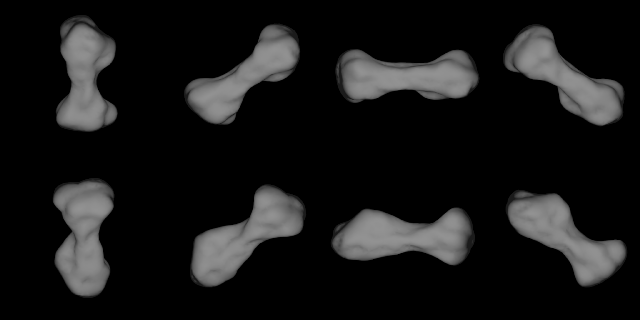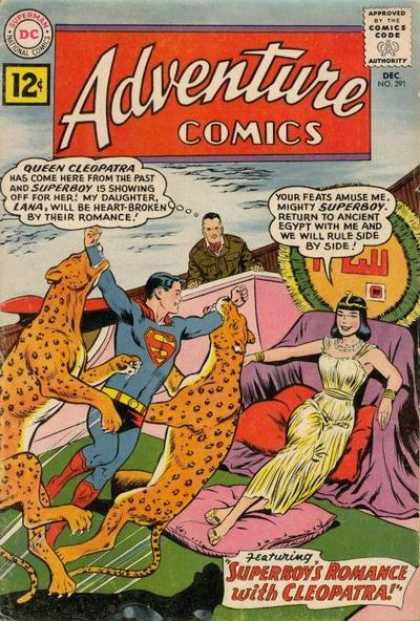Two Companions Found Near Dog-Bone Asteroid
Posted: Sun May 30, 2010 2:26 am
----------------------------------http://antwrp.gsfc.nasa.gov/apod/ap000510.html wrote:
Dog-Bone Shaped Asteroid 216 Kleopatra
Credit: Stephen Ostro et al. (JPL), Arecibo Radio Telescope, NSF, NASA
Explanation: <<An asteroid the size of New Jersey that orbits the Sun between Mars and Jupiter has been discovered to have an unusual dog-bone shape. Asteroid 216 Kleopatra, recently mapped with Earth-based radar, reflects radio waves so well that astronomers speculate it is composed mostly of metals such as nickel and iron. The unusual shape and composition of 216 Kleopatra may derive from the central regions of a tremendous collision between larger asteroids billions of years ago. Kleopatra is not completely solid - its surface is loosely consolidated rubble, although its core may contain large solid-metal lodes. Kleopatra will never strike the Earth, but it may one day serve as a valuable source of raw building materials.>>
http://www.seti.org/Page.aspx?pid=1182 wrote:
Two Companions Found Near Dog-Bone Asteroid
By Franck Marchis, Principal Investigator, SETI Institute, UC Berkeley
Composite image of (216) Kleopatra observed with the 10m-Keck II telescope and its Adaptive Optics system on September 19 2008 UT. The central dark circle shows the dog-bone shape of the primary. The arrows indicate the position of the newly discovered satellites with temporary names S/2008 (216) 1 and S/2008 (216) 2 (Credit: F. Marchis, et al, SETI Institute, UC Berkeley).
<<A team of astronomers led by F. Marchis, PI at the SETI Institute and at UC-Berkeley and P. Descamps from Paris Observatory announced recently the discovery of two moons around an intriguing asteroid. The main-belt asteroid 216 Kleopatra has two companions.
When Marchis observed this asteroid for the first time in October 1999 with the 3.6m telescope at ESO-La Silla in Chile, he did not know that he was starting a lengthy quest. The first data recorded with an adaptive optics system, which improves the angular resolution of the image on ground-based telescopes, reveal that the asteroid was made of two components. One year later, Steve Ostro, astronomer at the Jet Propulsion Laboratory, published an article in Science that summarized the analysis of radar observations that revealed that the mysterious shape of this M-type, main-belt asteroid. Since then, Kleopatra has been called the “dog-bone” asteroid. Its weird shape is probably the outcome of an impact event. The two lobes could be fragments resulting from the disruption of a parent asteroid that later gently collided to form a dumbbell-shaped body with overall dimension of 217 km by 94 km by 81 km.
To reexamine this interesting scenario and better determine the size and shape of this fascinating asteroid, Marchis led a team that obtained telescope time to observe the asteroid in September 2008. The observing schedule allowed the team to take advantage of the asteroid’s position when it was close to Earth at 1.2 AU. They used the Keck-II telescope, the largest optical telescope in the world located on the top of Mauna Kea, in Hawaii. The Keck Adaptive Optics system was recently improved and its large 10-m aperture produces images with an incomparable quality in sharpness (resolution up to 0.035”). Using the time-zone difference, Marchis’ collaborator, Pascal Descamps, located in Paris, France, participated remotely in the observations. Shortly after the first images were recorded and processed, they realized that the dog-bone shape model obtained by radar inversion agreed with the direct images recorded at the telescope. Descamps also pointed out that a tiny 5 km-sized moon was seen on the first images of Kleopatra. Additional data taken during this eventful night revealed a second fainter satellite (3 km-sized) that was closer to the primary.
Because of its elongated and bilobated shape, the team expected to detect companions around 216 Kleopatra. They predicted that the rubble-pile structure of the primary, linked with its fast rotation (~5 h), could result in ejection of fragments from the primary after an oblique impact that formed satellites. It is also possible that these moons are remnant of the catastrophic disruption of the parent asteroid, which were subsequently captured.
In 2005 the same team discovered in the asteroid belt the first triple system composed of two moons around 87 Sylvia (ref). Two years later, a second triple system (45 Eugenia) was discovered in the main-belt also using an adaptive optics system. These three systems are strikingly similar since all of them are composed of a large primary (diameter larger than 100 km) and their km-sized moons orbit very close to the primary. Without the improvement in image quality provided by the adaptive optics systems installed on Keck’s telescopes, these multiple asteroid systems would have remained unnoticed.
The team announced its discovery in an IAU circular 8980 on September 24. If more data are collected over the next few weeks, it will be possible to estimate the mutual orbits of the satellites and then infer the bulk density of this interesting M-type asteroid.>>




